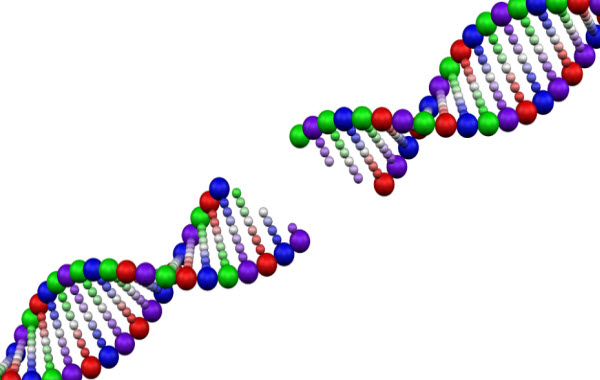DNA, short for Deoxyribonucleic Acid, is a complex organic molecule with a double helix structure. This molecule consists of two strands that twist around each other, forming the well-known double helix shape. DNA is present in all living cells, whether prokaryotic or eukaryotic, and in many viruses. Its primary function is to carry genetic information, which is crucial for passing traits from parents to offspring. DNA is also essential for the growth, development, and reproduction of all known organisms. It is stored within cells in long structures called chromosomes.
Composition of DNA
DNA is composed of units known as nucleotides. Each nucleotide contains three components:
- Phosphate Group: Consists of a single phosphorus atom linked to four oxygen atoms.
- Sugar Molecule: Known as deoxyribose in DNA.
- Nitrogenous Bases: Four types are present—adenine (A), thymine (T), guanine (G), and cytosine (C). These bases function together as “letters” that form the genetic code of our DNA.

The nucleotides link together to create two long strands that spiral into a structure known as the double helix. If you imagine the double helix like a ladder, the phosphate and sugar molecules make up the sides, while the nitrogenous base pairs form the rungs. The base pairs consist of adenine pairing with thymine (A-T) and guanine pairing with cytosine (G-C). It is estimated that the human DNA contains about 3 billion base pairs, with over 99% of these base pairs being identical among all humans.
Similar to how letters in the alphabet form words, the sequence of nitrogenous bases in DNA sequences forms genes, which encode for proteins. While DNA itself is not directly responsible for protein production, it provides the template for RNA, which then carries out the synthesis of proteins. RNA is similar in structure to DNA but has a single strand instead of two. It also contains three of the four nitrogenous bases found in DNA, using uracil instead of thymine to pair with adenine.
Chromosome Structure
DNA molecules are extremely long and must be compacted to fit inside cells. DNA is tightly coiled into structures known as chromosomes. Each chromosome contains one DNA molecule wrapped around protein spools called histones, which help maintain the chromosome’s structure. Humans have 23 pairs of chromosomes, and each cell nucleus, which serves as the control center of the cell, contains these chromosomes. Humans and most other mammals have a pair of sex chromosomes that can be either X or Y. According to the National Human Genome Research Institute, females have two X chromosomes in each cell, while males have one X and one Y chromosome. There can be natural variations in the number of sex chromosomes, leading to patterns such as XXY or XXX.
Discovery History
DNA was first observed by Swiss biochemist Friedrich Miescher in 1869, who used biochemical methods to isolate DNA from white blood cells and sperm. He identified it as a distinct substance from proteins. However, its significance remained unclear for many years. In 1952, chemist Rosalind Franklin, working in Dr. Maurice Wilkins’ lab, used X-ray diffraction to determine the structure of DNA, discovering its helical shape. Her work was crucial in identifying the structure that James Watson and Francis Crick described in their landmark 1953 paper in Nature. They proposed the iconic double helix model of DNA, with phosphate-sugar backbones and base pairs A-T and G-C. They also suggested that DNA could be replicated, allowing genetic information to be transferred. Watson, Crick, and Wilkins received the Nobel Prize in Physiology or Medicine in 1962 for their discoveries, although Franklin was not included despite her integral contribution.

Function of DNA
Genes encode proteins that perform various functions in humans and other organisms. For instance, the human gene HBA1 provides instructions for making the protein alpha-globin, a component of hemoglobin responsible for oxygen transport in red blood cells. The gene OR6A2 encodes an odorant receptor protein, influencing how we perceive smells, such as whether we find coriander pleasant or soapy.

Although each of the 37.2 trillion cells in the human body contains a copy of your DNA, not all cells produce the same proteins. This is partly due to molecules called transcription factors that bind to DNA, regulating which genes are turned on or off. Additionally, variations in DNA packaging across different cell types affect how transcription factors interact with the DNA. Epigenetics also plays a role, involving external modifications to DNA that can activate or silence specific genes.
Applications of DNA Testing
DNA contains information about a person’s heritage and can sometimes reveal susceptibility to certain diseases. DNA tests or genetic tests are used to diagnose genetic disorders, determine if an individual carries a gene mutation that could be passed to their children, and assess the risk of hereditary diseases. For example, mutations in the BRCA1 and BRCA2 genes are known to increase the risk of breast and ovarian cancers. Genetic testing can identify these mutations. Additionally, DNA tests are used to determine biological relationships, such as paternity testing.
